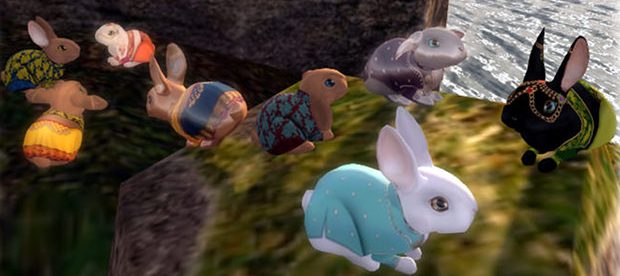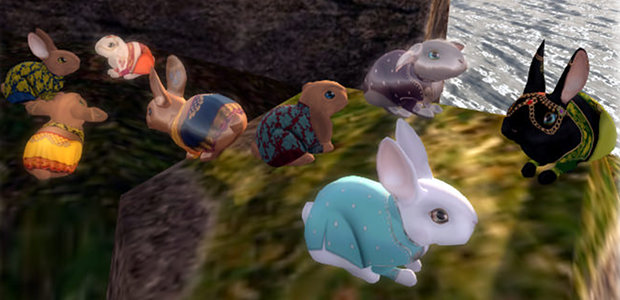The Great Virtual Rabbit Massacre of 2017

Rabbits can be pests — just ask anyone in Australia. The animals aren’t native to the island continent and, as an invasive species, grew to extraordinarily large populations (they bred like, well, rabbits), choking part of the nation’s ecology. It was a big problem, but that’s a story for another day.
It’s also a story that Second Life should be immune too. You’re probably not aware of Second Life — except for a brief heyday in around 2006, it’s found mostly niche appeal. If you want to know more about it, its Wikipedia entry is extensive, but for our purposes, the first paragraph of that will do:
Second Life is an online virtual world, developed and owned by the San Francisco-based firm Linden Lab and launched on June 23, 2003. By 2013, Second Life had approximately 1 million regular users. In many ways, Second Life is similar to massively multiplayer online role-playing games [MMORPGs]; however, Linden Lab is emphatic that their creation is not a game: “There is no manufactured conflict, no set objective”.
Like many other MMORPGs, Second Life has its own economy, only more so because unlike most other “games,” there’s really nothing else to do except participate in the economy and build yourself a virtual life. That can be profitable in the real world, too; there’s an exchange which allows Linden Dollars, the in-universe currency, to be converted into real currency. As a result, many entrepreneurs have built businesses inside the interface — businesses which are subject to real world laws and real world courts.
But let’s not get ahead of ourselves. First, let’s talk about a booming industry in Second Life — breedables, which are basically virtual pets. As VICE explains, “these scripted, modeled and animated objects take countless forms—from cats to chickens to dragons to shoes to flowers— with the general premise being that someone buys them blindly (usually in egg or nest form) with certain odds of getting rare versus common varieties.”
As of a year or so ago, Ozimal LLC was one of the businesses selling breedables in Second Life. Ozimal’s main business was bunny rabbits — virtual ones, of course. Per PC Gamer, “they eat, breed, they hop around a bit—pretty much what you’d expect from a real-life bunny, minus the poop under the couch,” and of course, they were really cute. Demand was high and, because they were nothing more than a bunch of 1s and 0s, supply was effectively infinite.

Ozimal had a winner on their hands — especially because of how the company monetized the “animals.” Ozimal rabbits, like regular rabbits, needed food, and in this case, Ozimal was the sole provider of that food. Using digital rights management (DRM) software, Ozimal created a system where the rabbits needed to connect to a central server to eat, and the rabbits’ owners needed to drop a few Linden Dollars here or there to buy food from that server. The more Second Lifers let their bunnies to breed, the more mouths there was to feed. Ozimal was making a virtual killing selling virtual pet food to virtual pets.
But it didn’t last. In 2016, Ozimal went bust. A former employee had, years prior, claimed that Ozimal was using his intellectual property in the creation of the rabbits without proper compensation. The legal fees were too much for Ozimal to handle — even very rich Second Lifers aren’t (usually)all that rich real lifers — so Ozimal folded. In an effort to keep the rabbits fed, a guy named Malkavyn Eldritch — sometimes cast as a volunteer, other times cited as Ozimal’s creator — kept the food server alive.
That lasted about a year. On May 15, 2017, the cease and desist letters came for Eldritch, too. Almost immediately thereafter, he announced that he was shutting down the servers, effective May 17th. As a result, the virtual rabbits would be unable to eat. (A few lucky bunnies had been enchanted to not need food, but they were still unable to breed after May 17th.) As Eldrtich wrote on a now-deleted (but archived) blog post — that server went down, too — the bunnies which can’t eat “will hibernate within 72 hours,” a euphemistically nice way to say that the bunnies were going to virtual-starve to virtual-death.
And that’s exactly what happened. By May 20, 2017, thousands of digital pets went to sleep forevermore, unless by some miracle the Ozimal servers can come back to life. Which isn’t very likely. But if it’s any solace, remember: no real animals were harmed in the making of this saga.
Bonus fact: How popular was Second Life during its heyday? As of April 15, 2012, the IRS had a recruitment office in the virtual world, and it was quite the experience. According to AccountingWeb, the tax-collecting agency’s (now defunct) virtual island featured a race track, penguins, a sandbox, a dance club, and “little virtual shops where you can purchase provocative women’s apparel for your avatar.” The IRS believed it was a bargain, too; unlike brand sponsorship of, say, NASCAR which could run into the hundreds of thousands of dollars (if not more), the Second Life experience cost only a few thousand bucks.
From the Archives: Down the Rabbit Hole: On Australia’s problem with rabbits.
Related: Google’s really cheap virtual reality viewer, Google Cardboard. It’s really neat and again, cheap at $15. Worth it for the novelty, although it lacks a long-term practical value. (I’ve used mine sparingly after the first few days, but the experience was so cool that I showed it to everyone once I got it.)
